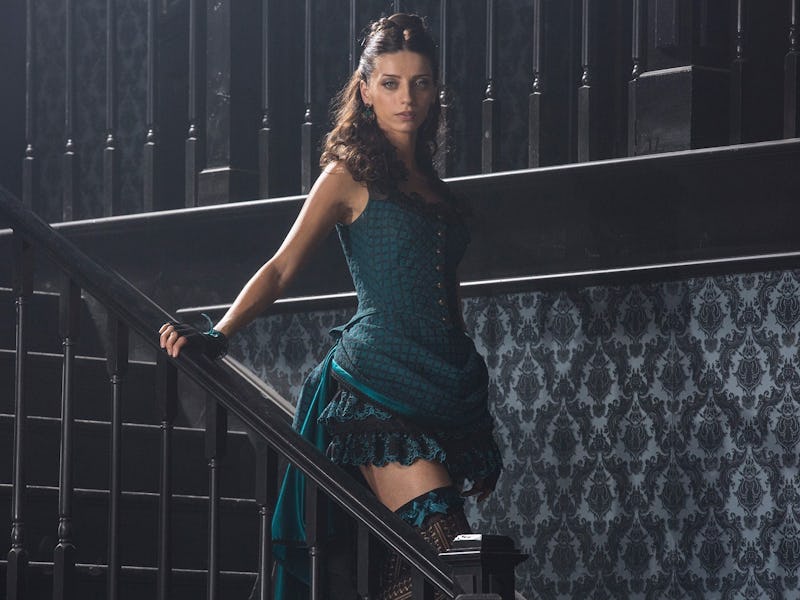It's Got Blood and Boobs, But 'Westworld' Is Far Deeper Than That
Is "Westworld" just an excuse for guilt-free blood and tits? We investigate.

From the outside, HBO’s Westworld, based on the 1973 movie of the same name, might seem like a melting pot of the material cable shows feature just because they can: copious amounts of blood, breasts, guns, and sex.
In reality, the show is the slyest form of storytelling, offering something for everyone. Depending on how deeply you engage with it, a story about an adult Wild West-themed park equipped with sex robots is an invitation to pass judgement on people who attend the park, or it’s a way to give the viewer violence and nudity without burdening them with pesky things like guilt (because it’s social commentary, guys!) or consequences for human characters. It isn’t real to the guests — if they decide to rape and murder, they’re doing it to robots — and it isn’t real to us either, because it’s just TV.
For people willing to look a third level deeper, the show reveals itself to be far from pure titillation or finger-wagging. It puts the viewer in the same “anything goes, here are blood and boobs for your enjoyment” place as the guests, but it also provokes us into feeling uncomfortable about it. Titillation mixed with discomfort has always been a heady combination.
James Marsden and Evan Rachel Wood in "Westworld"
In Hamlet — and yes, Shakespeare is relevant to Westworld — he tells a traveling troupe of actors that the purpose of their craft is to hold the mirror up to nature. “Show virtue her own feature, scorn her own image,” he says. Holding the mirror up to nature is a quality Westworld has in spades.
And what’s reflected back at us? Blood and orgies, naturally. The 1973 movie goes most of the way there, but with its 90-minute run time and period prudishness, it doesn’t quite go as far as a 2016 HBO drama can. The first two acts have an intriguing set up; the third ditches the social commentary in favor of an extended chase sequence. All of the robot women in it are beautiful in a particular way that reflects the time: doe eyes, Farrah Fawcett-like feathered hair. In that regard, it’s operating on that second level: In the movie’s universe, the women are purposefully designed by the scientists to appeal to the park visitors, and in the real world, they’re designed by the scriptwriters and studio execs to appeal to the audience.
Although the TV show takes the premise in far more nuanced directions than simply “the robots malfunction and start killing everyone,” it also dips into this second level. The main female characters are more varied to reflect our current beauty standards — Thandie Newton is featured prominently; the women in the original film are all white — but they’re still all attractive in a very mainstream way, a way that assumes that, just as park guests want to see blood and tits, so do the viewers at home. Make no mistake, that is inherent to the story’s appeal.
Thandie Newton and Rodrigo Santoro in Westworld
There’s a reason that Evan Rachel Wood — Westworld’s heroine of sorts — also starred in the ‘60s era Beatles homage film Across the Universe. Had she lived in the ‘70s, she surely would have been cast as a robot in the Westworld film.
This might be a problem if the show wasn’t conscious of it, but luckily, it is. It knows its cast of robot women (and men) are being extravagantly objectified, and it acknowledges it in deviously clever ways. The robots are all programed to act out “storylines” to seem as realistic as possible to both park visitors and show-viewers. In the second episode, one of the men behind the scenes responsible for crafting the robot “storylines” explains a lurid, uber-violent new concept, reasoning that he’s doing it because it’s what the park guests want. It’s who they are. As Anthony Hopkins’s enigmatic designer observes, “The only thing this tells me is who you are.”
The same can be said of Westworld’s inherent appeal and lasting impact in pop culture. The show will be a hit because it’s a brilliant Chinese puzzle box of narrative with infinite unexpected turns and layers of meaning for those who seek them out. It says a lot about human nature in its characters, but also speaks volumes about us. And although the story and robots are getting masterfully crafted updates, our areas of titillation remain the same today as they were in 1973, give or take a software upgrade or two.
Westworld doesn’t just hold the mirror up to nature, it provides a wild funhouse, and damn is it going to be a ride.
The series premieres October 2 on HBO.